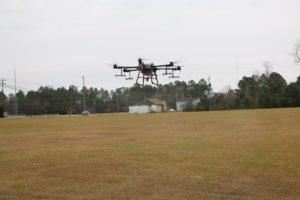As South Carolina corn and soybean farmers prepare for the 2023 growing season, Clemson Extension specialists have a few tips to help ensure productive and profitable crops.
These suggestions were given to about 220 participants who attended the December 2022 Clemson Cooperative Extension Service Corn and Soybean meeting in Santee, South Carolina. One suggestion is to pay attention to new crop insurance planting date deadlines for soybeans starting this year (2023).
Clemson Extension corn and soybean specialist Michael Plumblee told soybean farmers they will be able to get crop insurance coverage starting on April 1 for soybean in 2023. This date was moved up from the previous dates of April 30 for the coastal plain and April 15 for the upstate, allowing for coverage on earlier planted soybean in South Carolina.

Michael Plumblee
“Additionally, the final planting date has been moved back to June 30 from June 25 for full coverage, and the absolute last day to plant and have reduced coverage still remains July 10,” Plumblee said.
These date changes were made possible by working through the Farm Bureau Soybean, Hay and Feed Grain Committee; the Risk Management Agency office in Valdosta, Georgia, as well as the South Carolina Soybean Board and Clemson University.
As for corn, the United States Department of Agriculture’s (USDA) unofficial baseline projections forecast farmers are likely to expand plantings for the 2023/2024 season while reducing soybeans. Plumblee says farmers should use local hybrid and varietal trial data when making selections for 2023, paying close attention to disease resistance packages in scenarios where crop rotations may be short. Clemson corn variety test data is available at https://www.clemson.edu/cafls/research/vt/corn.html.
Plumblee also talked about a project he and graduate student Bennett Harrelson are working on related to double-cropping soybean after corn. The researchers are looking at plant and harvest dates, row spacing, and the use of at-plant nitrogen. They also are studying to determine if this double-cropping system leads to issues with increased plant parasitic nematodes.
Deer, insect pests and Bt resistance
Farmers were advised of actions to take to control deer and insect pests.
Using repellents is one way to control deer but can be expensive. Kendall Kirk, a precision agriculture engineer, said installing high fences around crops may be less costly.
Insect pests create additional problems. Entomologists Francis Reay-Jones and Jeremy Greene, together with Clemson IPM Program assistant coordinator Tim Bryant, talked about corn and soybean insects. Most of the state’s corn acreage is planted in Bt (Bacillus thuringiensis) corn. Resistance issues with corn earworm in Bt corn are leading to resistance issues in Bt cotton. The corn earworm also is known as the bollworm and attacks cotton. Farmers may be dealing with resistance issues for some time, as Reay-Jones said, “We are years away from any new Bt trait in corn and cotton.”
Stink bugs also are a problem. Applying pyrethroids can be effective “but scouting and timely applications are important,” said Bryant, adding South Carolina farmers can get disease and insect management information from the free MyIPM for Row Crops app.
Pyrethroids also are effective in controlling stink bugs and kudzu bugs in soybean, Greene said. Treatment thresholds are one to two stink bugs per sweep for stink bugs and one nymph per sweep for kudzu bugs. Following these guidelines can help reduce the need for multiple sprays.
Pyrethroids are not effective for the soybean looper, which causes problems from mid-August to mid-September. The threshold for soybean loopers is 30% defoliation before mid-bloom and 15% after. This pest is resistant to many insecticides and costs more to control.
Spray drones
Guest speaker Steve Li, associate professor of weed science at Auburn University, talked about using drones to spray row crops.

Interest in using drones in agriculture is high among growers, crop consultants and pesticide applicators.
“Spray drones make it easy for growers with small acreage, slopes, or challenging field shapes to make field applications without taking a boom sprayer in the field or contracting a crop duster,” Li said.
The end goal is not to replace current application methods, but to find methods to work spray drones into field management. Drone use in field crop farming is low because the technology is still new. However, Li said interest is high among growers, crop consultants and pesticide applicators. He believes the ease of use will increase the adoption rate of drones.
Other speakers included Dean Hutto, S.C. Soybean Board chairman; Mary Cromley, S.C. Corn and Soybean Association executive director; Ed Wilkins, S.C. Farm Bureau Mutual Insurance; Rick Caldwell, S.C. Farm Bureau; Ashley Carothers, S.C. Department of Health and Environmental Control, and Alexa Combelic, director of government relations for the American Soybean Association.
A drone demonstration followed the meeting.
Source : clemson.edu